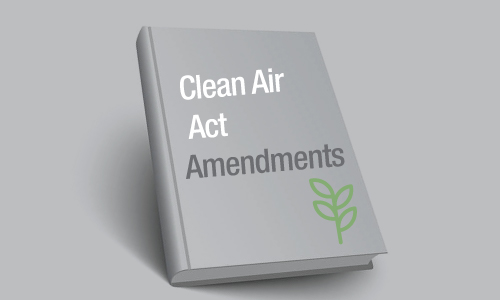How well do you know your air pollution regulations and laws? We’ve spent a lot of time looking at different considerations regarding air pollution, starting with a lawsuit in first century AD, a royal edict on pollution in the 1300s, and early efforts to cull air pollution throughout the years, culminating in laws passed in the 1950s, 1960s and 70s that lead us to today’s blog on the Amendments to the Clean Air Act which shaped the current regulatory environment.
CAA Amendments of 1977
The Carter Administration, along with one of the initial proponents of the 1970 Act, looked to make modifications to push forward major changes while retaining the fundamental approach of the 1970 statute. The 1977 amendments adjusted the auto emission standards, extended deadlines for the attainment of air quality standards, and added the Prevention of Significant Deterioration program to protect air cleaner than national standards.
Prevention of Significant Deterioration (PSD)
The PSD program reflects the principle that areas where air quality is better than that required by NAAQS should be protected from significant new air pollution even if NAAQS would not be violated. The PSD program is designed to keep interference from air pollution in certain areas like National Parks at a minimum. Additionally, newly constructed buildings around PDS areas may have to comply to higher Best Available Control Technology (BACT) standards than other new builds.
Clean Air Act Amendments of 1990
In 1990, President George H.W. Bush signed into law the Clean Air Act Amendments of 1990, a law setting forth a multitude of new controls and considerations that needed to be made in order to gain or remain compliant with the Clean Air Act. While some of the regulations built on top of the initial Act, the 1990 Amendments included major deviations from previous standards such as Nonattainment Requirements, which will be discussed below.
Hazardous Air Pollutant List
In the early days of the Clean Air Act, only a set number of chemicals were targeted for enforcement and reduction. The Clean Air Act Amendments of 1990 expanded the list from six to 189 and set standards for the addition and subtraction of chemicals. We discussed the impact of HAPs in a recent blog, which you can read here.
Nonattainment Requirements
Nonattainment areas were, in simple terms, localities where air pollution levels persistently exceed National Ambient Air Quality Standards (NAAQS), or areas contributing to elevated NAAQS in nearby areas. The EPA classifies specific areas exceeding regulations based on severity—marginal, moderate, serious, severe and extreme—and sets requirements for each area based on this classification.
Depending on the criteria pollutant, areas found to be exceeding NAAQS were classified on severity, and in turn were compelled to adapt different standards in order to achieve acceptable emissions meeting NAAQS. EPA designations of nonattainment areas are only based on violations of national air quality standards for carbon monoxide, lead, ozone (1-hour), particulate matter (PM-10), and sulfur dioxide. EPA has not yet designated areas based on the newer 8-hour ozone or PM 2.5 standards. Currently, there are no nonattainment listings for nitrogen dioxide. For specific standards on nonattainment areas, see the Congressional Research Service Article on the CAA and Amendments.
Permit Programs
The Amendments of 1990 also set forth a permitting process to be adopted with the help of states. This program was modelled after a similar program under the Federal National Pollution Elimination Discharge System (NPDES) law. The purpose of the operating permits program is to ensure compliance with all applicable requirements of the Clean Air Act and to enhance EPA’s ability to enforce the Act.
For more information on the permit program, see the EPA summary of Title V explaining the process.
Additional Considerations: Mobile Sources, Acid Deposition, and More
The 1990 Amendments were very deep and very complex, relying on a lot of new technology from companies and measurement capabilities for enforcement. Among the additional focuses of the act were the enforcement of mobile sources, the move to reduce CFCs and other consumer-produced environmental depleting chemicals, and the work done to reduce Acid Rain. For more information, see the EPA guide to the 1990 Amendments.
Recent, Smaller Bills Pertaining to the Clean Air Act
While the major amendments occurred in 1970, 1977, and 1990, with various reauthorizations occurring throughout the years, there were other smaller bills leading up to present day that could affect different industries.
- Acid Precipitation Act of 1980
- Chemical Safety Information, Site Security and Fuels Regulatory Relief Act (1999)
- Energy Policy Act of 2005
- Energy Independence and Security Act of 2007
Conclusion: It Pays to Keep Up with the Times
Just because the last amendment to the CAA passed in 1990 doesn’t mean you should be lax on taking control of your emissions. In the past few decades, there have been more and more lawsuits against polluters, international attempts to reduce pollution, and additional activist focus on fighting polluters.
Simply put, emitting clean air is good business. Learn more about HAP and VOC Abatement Tactics and Strategies, success stories, and tools used to fight pollution by contacting The CMM Group.




